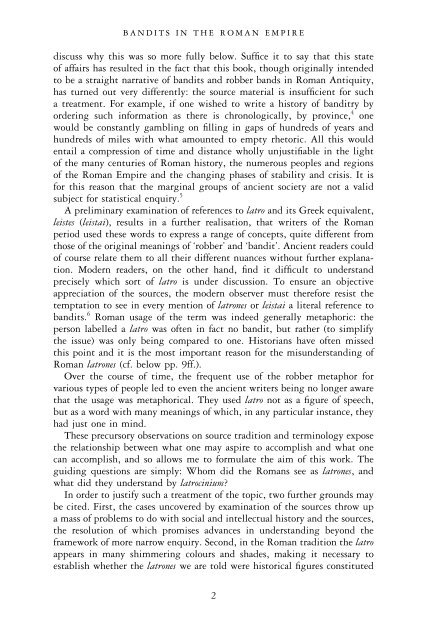Create successful ePaper yourself
Turn your PDF publications into a flip-book with our unique Google optimized e-Paper software.
BANDITS IN THE ROMAN EMPIRE<br />
discuss why this was so more fully below. Suffice it to say that this state<br />
of affairs has resulted in the fact that this book, though originally intended<br />
to be a straight narrative of bandits and robber bands in Roman Antiquity,<br />
has turned out very differently: the source material is insufficient for such<br />
a treatment. For example, if one wished to write a history of banditry by<br />
ordering such information as there is chronologically, by province, 4 one<br />
would be constantly gambling on filling in gaps of hundreds of years and<br />
hundreds of miles with what amounted to empty rhetoric. All this would<br />
entail a compression of time and distance wholly unjustifiable in the light<br />
of the many centuries of Roman history, the numerous peoples and regions<br />
of the Roman Empire and the changing phases of stability and crisis. It is<br />
for this reason that the marginal groups of ancient society are not a valid<br />
subject for statistical enquiry. 5<br />
A preliminary examination of references to latro and its Greek equivalent,<br />
leistes (leistai), results in a further realisation, that writers of the Roman<br />
period used these words to express a range of concepts, quite different from<br />
those of the original meanings of ‘robber’ and ‘bandit’. Ancient readers could<br />
of course relate them to all their different nuances without further explanation.<br />
Modern readers, on the other hand, find it difficult to understand<br />
precisely which sort of latro is under discussion. To ensure an objective<br />
appreciation of the sources, the modern observer must therefore resist the<br />
temptation to see in every mention of <strong>latrones</strong> or leistai a literal reference to<br />
bandits. 6 Roman usage of the term was indeed generally metaphoric: the<br />
person labelled a latro was often in fact no bandit, but rather (to simplify<br />
the issue) was only being compared to one. Historians have often missed<br />
this point and it is the most important reason for the misunderstanding of<br />
Roman <strong>latrones</strong> (cf. below pp. 9ff.).<br />
Over the course of time, the frequent use of the robber metaphor for<br />
various types of people led to even the ancient writers being no longer aware<br />
that the usage was metaphorical. They used latro not as a figure of speech,<br />
but as a word with many meanings of which, in any particular instance, they<br />
had just one in mind.<br />
These precursory observations on source tradition and terminology expose<br />
the relationship between what one may aspire to accomplish and what one<br />
can accomplish, and so allows me to formulate the aim of this work. The<br />
guiding questions are simply: Whom did the Romans see as <strong>latrones</strong>, and<br />
what did they understand by latrocinium?<br />
In order to justify such a treatment of the topic, two further grounds may<br />
be cited. First, the cases uncovered by examination of the sources throw up<br />
a mass of problems to do with social and intellectual history and the sources,<br />
the resolution of which promises advances in understanding beyond the<br />
framework of more narrow enquiry. Second, in the Roman tradition the latro<br />
appears in many shimmering colours and shades, making it necessary to<br />
establish whether the <strong>latrones</strong> we are told were historical figures constituted<br />
2


